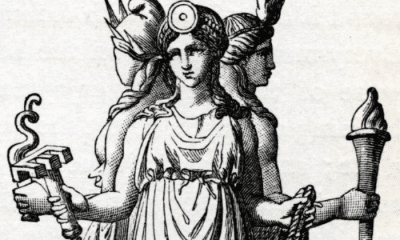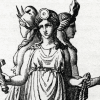Greek
What is Hestia’s Symbol?
While many of the gods of Greece had elaborate iconography, the few images of Hestia are as unassuming as the goddess herself.
Most gods and goddesses of the Greek pantheon had specific symbols and attributes that could be sued to identify them in art and represent them in worship.
Apollo, for example, had his lyre and bow as well as several sacred plants and animals. His sister Artemis was seen with wild animals and dressed for running through the forest.
The major gods of Olympus all had identifying features of some sort. One, however, did not.
Hestia was the goddess of the hearth. While she played a key role in the religion of Greece, she was noticeably absent from its mythology and iconography.
Hestia was so rarely portrayed that no clear symbolism ever emerged in relation to her. While she was sometimes shown sitting beside the fire, her place in Zeus’s household was the only thing that distinguished her from an anonymous veiled woman on the rare occasion she was shown at all..
The Unassuming Iconography of Hestia
Hestia was one of the three sisters of Zeus. Both her brother Poseidon and her nephew Apollo asked to marry Hestia, but the goddess requested something different of Zeus.
Hestia had no interest in marriage and swore an oath before her brother that she would never marry. Zeus accepted this vow and forbade the other gods from pursuing her any more.
Zeus brought Hestia into his own household to live in a position of great honor. The virgin goddess tended to his fire and became the goddess of the hearth.
Keeping a fire may seem like a mundane task, but in the Greek world it was a sacred duty. The hearth was the center of the home and letting the fire go out would be a sign of neglect toward the family.
As Zeus’s fire keeper, Hestia served an even more important function. She was the first recipient of all the burnt offerings sent to the gods by the humans below.
Hestia’s role on Olympus was important, but it also left the goddess in a position to be often forgotten and ignored.
Because she was busy tending to her brother’s fire and receiving his sacrifices, Hestia did not play in important role in any of the myths of the other gods. She took no lovers, did not participate in war, and never left her place by the hearth to interfere in the lives of mortals.
Hestia also had few temples. Because all offerings went through her she was invoked in many sacrifices, but almost none were made in her name alone.
Those that were were given to Hestia as a household goddess. By the hearths of Greek homes, Zeus’s virginal sister was invoked as a goddess of domesticity.
Hestia played an important role in Greek religion, but a minor one in its mythology. Because of this she was rarely left out in art.
Because of these, there was little iconography connected to Hestia. When she was shown it was most often sitting next to a fire or with a flame burning next to her in a direct reference to her duty.
Often, even this means of identification was missing. Among some groups of goddesses, Hestia could be recognized by her demure style of dress, but when seen near maternal goddesses her usual long robes and veil were not unique.
The lack of symbolism connected to Hestia was not lost on the Greeks themselves. One later writer claimed that Hestia herself had chosen to not take any symbols to keep her life more simple.
My Modern Interpretation
Hestia’s role in the Greek pantheon kept her largely out of the public eye.
With few temples in her name or depictions in art, there were also few opportunities to show Hestia with any type of iconography. Because she was not included in the dramatic myths of the Olympians, there were no images that could be drawn from particular stories to represent her.
Hestia played an important role in Greek religion, but images of her are almost nonexistent.
In many ways, the figure of Hestia can be seen as a parallel to the lives of ordinary women in Greece.
Out of concerns for both safety and propriety, most women in the Greek world lived a relatively secluded life. They spent time in their homes and near their families, but public appearances were rare.
Noble women in Greece rarely left their homes, even to shop for necessities. Servants and slaves ran errands and delivered messages while the lady of the house stayed safely indoors.
This was especially true for unmarried women. Greek marriages often began with an abduction, so girls never left home without several male relatives nearby to keep them safe.
Women only needed to look at the stories of Zeus and his many mistresses to know how dangerous it could be to leave their homes by themselves.
These women, like Hestia, were important members of the family unit but were unseen in public. They managed the household, cared for the children, and tended the fire while others lived more flamboyant lives in the outside world.
Remaining largely indoors, these women were also like Hestia in that there was little need for them to adorn themselves. While Aphrodite wore jewels to flaunt her beauty and Artemis carried her bow to hunt, the women who say by their home’s fireside did not need to advertise their position to anyone.
When they were seen, the proper wives and daughters of the Greek world were seen much like Hestia was. They dressed simply and conservatively, with a veil covering their hair and their eyes lowered.
Drawing attention to oneself would be frowned upon for women of the upper classes. A well-behaved wife or daughter was meant to embody the virtues of piety, obedience, and duty to family.
Because she reflected domestic life and indoor spaces, there was no need for Hestia to have elaborate symbols or iconography. She was, like many women in the Greek world, meant to be a figure in the background who kept the fires lit but did not draw attention to herself.
In Summary
As the goddess of the hearth, Zeus’s sister was intrinsically tied to a place within the home.
There were few temples to Hestia because she was invoked with all other sacrifices both in sanctuaries and in homes. There were few images of Hestia because she featured in no dramatic myths and legends.
Because Hestia was so rarely shown, no distinct iconography was created in relation to her. When not shown beside a fire, she could be mistaken for any average Greek woman.
In some ways, Hestia’s invisibility in public life and lack of adornment made her more like those average women than the other goddesses. In a patriarchal culture that kept women largely confined in the home, Hestia’s lack of representation mirrored the lived experience of the women who kept the fires burning in their own homes.



